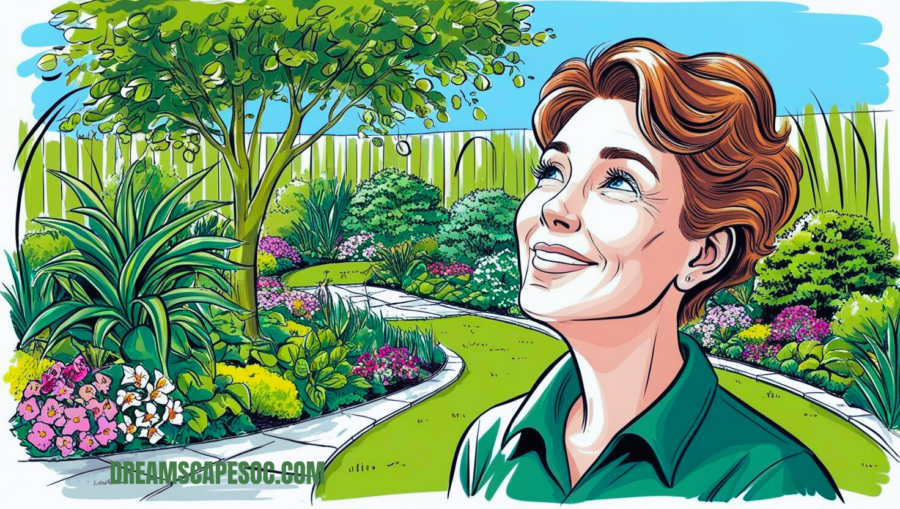Why Get a Backyard Greenhouse?
You are no longer constrained by the seasons when you have a greenhouse in your backyard. You can cultivate various flowers, herbs, and vegetables regardless of the weather. Consider this: you shield your plants from pests and are no longer constrained by extraordinarily high or low temperatures. With a greenhouse, you can rest easy knowing that your plants are in a secure setting.
Click here for your copy of Landscaping Design Ideas.
Key Takeaway: A backyard greenhouse offers control over your garden’s climate, making it easier to grow your favorite plants year-round while keeping them safe from pests and harsh weather.
Types of Backyard Greenhouses
When setting up a greenhouse, you’ll find several types. Each style has unique benefits, depending on your garden’s needs, space, and budget.
- Permanent Structures: A greenhouse can be your best option if you’re prepared to commit. These greenhouses offer a dependable, long-term growing environment since they are constructed of sturdy materials like glass or polycarbonate. Space. Because they’re stable and well-insulated, you can easily add heating and cooling systems and garden through any season without a hitch.
Permanent structures are incredibly stable and ideal for advanced installation. However, they are a bit pricier and require a dedicated space in your yard. So, if you’re serious about gardening year-round and have the room, a permanent structure might be the way to go.
- Moveable Greenhouses: If you want flexibility, consider getting a portable greenhouse. Usually constructed of lightweight materials like plastic, these greenhouses are intended to be easily moved or disassembled. They’re perfect for those who want to experiment with greenhouse gardening without investing significantly.
Portable greenhouses are perfect for tiny yards, inexpensive, and portable. However, they’re less durable, and you may need to bring them indoors during severe weather. They’re ideal if you start or want to move your greenhouse to different parts of your yard throughout the year.
- DIY vs. Ready-Made Kits: Many gardeners love the DIY route because it lets them create a custom setup tailored to their landscape. You have complete control over the size, shape, and materials, but ready-made kits are a great alternative if you do not like building things. Kits are perfect for novices or anyone wishing to begin developing rapidly because they come with all the pre-cut pieces and are simple to assemble.
Going DIY is best if you’re looking for a unique setup and are handy with tools. Meanwhile, kits are user-friendly and take the guesswork out of construction, though they may limit customization options.
Transform Your Outdoor Space Today – Download Your Free Landscaping and Gardening Checklist
Selecting the Ideal Site for Your Greenhouse
The location of your greenhouse has a big impact on its success. Selecting the perfect spot guarantees that your plants get the access, light, and shade they need.
Sunshine Exposure: Ideally, your greenhouse should be facing south to receive the most sunshine possible. Sunlight is the primary source of warmth for the greenhouse, so avoid areas shaded by trees or buildings. Ensure your plants get at least six hours of direct sunlight daily to help them thrive!
- Drainage and Soil Quality: Proper drainage is essential to keep water from gathering around your greenhouse, helping to avoid issues like mold and root rot. If the ground is uneven, smooth it out or throw down some gravel to allow drainage. Some people lay a concrete or wooden foundation to stabilize their greenhouse and dry the area.
- Accessibility and Proximity to Water Sources: Place your greenhouse somewhere easy to reach, preferably close to a water source. This makes watering, checking plants, and harvesting much more effortless. If your greenhouse is convenient to access, especially in colder months, you’re more likely to give your plants the care they need consistently.
Essential Features of a Productive Greenhouse
To make your greenhouse as productive as possible, you’ll need a few essential features to control and organize the environment.
- Ventilation and Airflow: Ventilation is key to preventing overheating and keeping the air moving. Stale, humid air can encourage mold, so vents should be installed in the roof or walls to release excess heat. Many gardeners also add fans to improve airflow, and you can even automate these vents for easier temperature control.
- Heating and Cooling Systems: Stable temperatures are vital if you’re growing year-round. For colder months, a small electric heater or even a propane heater can keep frost at bay. In hotter months, fans and shade cloths can keep things cool. Some setups include evaporative coolers, but these are usually only necessary in very hot areas.
- Shelving and Organization: Vertical space is your friend. By adding shelves, racks, and plant stands, you can maximize space and fit more plants in your greenhouse. Modular or stackable shelves let you adjust as your plants grow and make it easy to add new varieties when needed.
| Pest | Solution |
| Aphids | Soapy water or neem oil spray |
| Whiteflies | Sticky traps or insecticidal spray |
| Spider Mites | Rinse plants; apply neem oil |
| Fungus Gnats | Let the soil dry; use sticky traps |
| Caterpillars | Hand-pick or organic insecticide |
| Mealybugs | Dab with alcohol or insecticidal soap |
| Scale Insects | Scrape off; apply neem oil |
Best Plants to Grow in a Backyard Greenhouse
Greenhouses are a versatile environment for many plants, so you have plenty of options. Here’s a quick guide to the types of plants that thrive in these conditions.
- Vegetables: Popular greenhouse vegetables include tomatoes, cucumbers, and peppers. These plants love the warm, stable environment, and greenhouses protect them from outdoor pests. Tomatoes and cucumbers do especially well in greenhouses and produce generous yields when they have consistent warmth and light.
- Herbs: Herbs like basil, cilantro, and mint are excellent choices. They’re fast-growing, fragrant, and perfect for greenhouse conditions. Basil especially thrives in the warmth, while mint will flourish but may need to be contained so it doesn’t overrun other plants.
- Flowers: Greenhouses aren’t just for edible plants. Orchids, geraniums, and fuchsias do wonderfully in greenhouses, adding beauty and variety. Orchids love the humidity, while geraniums and fuchsias add vibrant color and require only moderate care.

Year-Round Greenhouse Gardening Tips
Once your greenhouse is set up, keeping it productive all year requires some seasonal adjustments and regular care.
- Seasonal Planning: Greenhouses allow you to plan for every season. For instance, spring and summer are great for warm-weather plants like tomatoes and cucumbers. You can switch to cool-season crops like lettuce, spinach, and root veggies during fall and winter. Keeping a gardening calendar helps you track what you’re growing and when to harvest.
- Temperature Management: Temperature control is a big part of successful greenhouse gardening. Use thermostats to adjust your heating and cooling systems and check temperatures daily. For optimal growth, try using a thermometer with a humidity gauge to keep track of both elements, especially during seasonal shifts.
- Pest and Disease Control: Greenhouses are generally safer from pests, but insects or diseases can still find their way inside. Keeping your plants healthy is easy with regular cleaning and pest checks. Additionally, you can assist by using natural methods for controlling pests, such as neem oil or insecticidal soap!
Maintenance and Upkeep
Maintenance goes a long way in keeping your greenhouse productive and your plants happy.
Maintaining Regular Cleaning: To avoid mold and illness, cleanliness is crucial. Clean pots and trays regularly, remove fallen leaves, and wipe down surfaces. Healthy plant and fewer pests are also benefits of a clean greenhouse.
Equipment check: Keep an eye on your greenhouse’s equipment, such as heaters, fans, and vents, to ensure they work correctly. Checking regularly, especially before cold months, helps avoid surprises and keeps your plants safe from sudden temperature shifts.
Soil and Fertilizer Management: Greenhouses deplete soil nutrients faster, so it’s essential to refresh soil between growing cycles and use high-quality fertilizers. Regularly adding nutrients helps your plants grow stronger and keeps them productive for longer.
Conclusion
Growing fresh veggies, herbs, and flowers anytime you want is possible with a backyard greenhouse, which is a worthwhile investment. You may design a lush, fruitful space that improves both your landscape and your way of life with the correct arrangement, placement, and maintenance.
FAQs
How much does it cost to build a backyard greenhouse?
It starts at around $100 for small DIY setups and goes up to over $5,000 for more extensive, permanent greenhouses.
Do backyard greenhouses work in cold climates?
Yes, you can use a greenhouse in cold climates. Adding a heating system will help maintain a stable environment during winter.
What’s the best material for greenhouse covers?
Polycarbonate panels are popular for their durability and insulation, while glass offers excellent light but is heavier and more fragile.
How often should I water plants in a greenhouse?
How often you water depends on the plant type and the season. In general, plants in a greenhouse need regular watering because they’re in a closed environment.
Can I start seeds in my backyard greenhouse?
Absolutely! Greenhouses create an ideal environment for seed germination, providing stable temperatures and protection for young plants.


